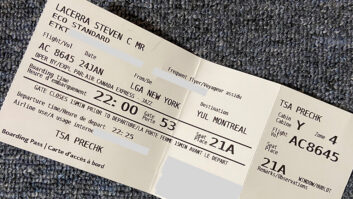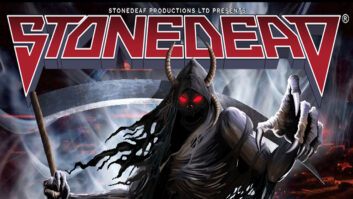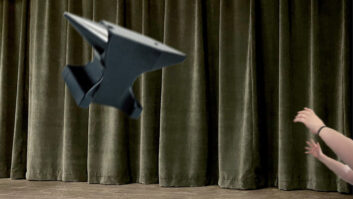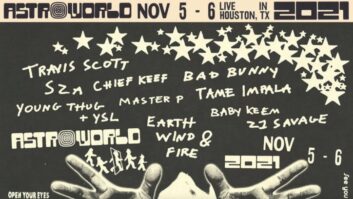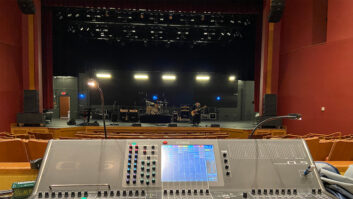Big-time recording artists receive the box-set treatment from record labels, but it takes quite a movie to receive the same level of attention. The Criterion Collection, a New York-based company that has a penchant for presenting high-quality editions of off-centered cult flicks, felt that Brazil was that kind of movie, one whose fans would search for everything related to the project.
When released in 1985, Terry Gilliam’s brutal, darkly humorous epic brought viewers into State employee Sam Lowry’s (Jonathan Pryce) desperate, fantastical dreams and pursuit of self-identity in an upside-down Orwellian Bizarro world. Nearly 15 years later, it remains a fixture on the art-house circuit and a favorite in the rental world.
Criterion started work on a five-laserdisc set of the movie in 1993 and then went into a three-year hiatus to work out some studio and rights issues. It finally came out on laserdisc in 1996.
“We thought that we were going to be able to put the disc out, but then MCA put the kibosh on it, and so the movie languished for many years,” says Michael Wiese, audio coordinator for the Brazil project. “For years, fans of the movie kept calling up, and we could’ve created a full-time job for someone to do nothing but deflect perturbed potential consumers.”
Now, the three-DVD set features the “final final” directorial vision of the movie, as well as a documentary (The Battle of Brazil) that showcases the legal battles Gilliam had with universal at the time. The set also features the “Love Conquers All” syndicated television version, which includes all the edits that Gilliam refused to make. There are also loads of arcane bits that true fans will love.
“One of the things that I think is most extraordinary about this release is its completeness,” says Criterion President Peter Becker. “The fact that there was a big story to tell, and that everybody we needed to hear from agreed to be part of the release, was very exciting. It took a long time.”
The sound for Brazil was mixed from the 35mm Dolby Stereo magnetic tracks. The re-recording mixer on the original release was Paul Carr II, who also did The Meaning of Life and The Fisher King with Gilliam. Rodney Glenn was credited as sound editor, Bob Doyle as sound recordist; and Rosie Straker was boom operator. Michael Kamen composed the score.
“This is the Director Approved Edition, and Terry was satisfied with the original Lt/Rt, and that is what really matters,” says Wiese. “The master for the laserdisc is a D2 videotape. We also use Digi Beta for our DVD masters. They are both very high-quality formats.”
In the case of creating the “final” final master, where Gilliam pieced together elements from various versions of the movie, Criterion had to go to some extra effort to find some missing audio.
“When Terry made the original movie, there was a short scene that he decided to lose before the European premiere,” says film transfer producer Karen Stetler. “Later, he regretted cutting it out, and he liked it, so we had to dig up the footage for that scene. As it turned out, that scene was still in the camera negative that was in London. So we went out to the lab where the camera negative was stored and looked at the negative, and there it was sitting right there, which was great. The only thing about it was that we didn’t have the audio to match it.”
After calling around to unearth the matching audio elements to the scene, Gilliam and Stetler found a 1-inch video master someone had made of a version that featured the deleted scene.
Converting Brazil’s dynamic audio tracks to 5.1 was never discussed, as the idea of undertaking such a mix would’ve been almost impossible since the multitracks from the various versions of the film were not all accounted for.
“We wouldn’t have been able to cut back and forth between what I would’ve found for the American and European versions. There are a lot of cuts, and many of them were significant,” says Criterion transfer supervisor and DVD quality control guru Maria Palazzola. “We just went Lt/Rt, because we could find the Lt/Rt for the different versions and made it a clean edit in and out of the different versions.”
Even if the multitracks had been readily available, keeping the film in sync with the way the director meant to present it at its release is the philosophical position that Criterion follows.
“If you are using the stereo surrounds just for the sake of using the stereo surrounds, it can sound kind of gimmicky,” says Wiese. “I don’t think that is really going to add to the value of the re-release, unless it is being done for a real reason. We felt that the mixes that existed were very good. [It was mixed by Paul Carr originally]. It is representative of the period, and it shows what mag can do, and that it is still a very viable medium.”
Criterion excels at commentary, which is painstakingly assembled through many hours of interviews and subsequent edits. For Brazil, Gilliam provides loads of detailed observations on everything from the symbolism of Lowry’s dreams to ideas that were attempted and not included.
“Building a commentary is really like doing a crossword puzzle,” says Wiese. “You have several comments that are very scene-specific. You know they have to be in there, and you lay those in and really try to fit in all of the other points around them, much like a crossword puzzle. It all has to make a kind of linear sense, and it has to fit into the picture. It is tricky.”
The commentary, which was originally recorded for the laserdisc version in the early ’90s, was recorded on DAT with cassette backups. As it turned out, there were problems with the DAT, so the cassette commentary was used and dumped into Deck II, which was then directly laid back into the D2 master.
“Deck II was popular right before Pro Tools was getting going. It was a great little program, as long as you didn’t need more than a couple of tracks,” Wiese laughs.
“When it came time for Criterion to do the DVD edition, all of the laserdisc master elements were loaded into a Pro Tools|24 system, where they were carefully evaluated by Ken Hansen, Will Salas and Heather Shaw,” states Wiese. “They went through the audio tracks with a fine-toothed comb, and the necessary adjustments were made at this point, including some very gentle noise reduction and spot fixes in a CEDAR system. The original elements were solid, and the work that we did was very subtle.”
“The movie was in great shape,” Wiese concludes. “Obviously, you don’t want to add artifacting for restoration processes if you don’t need to do that. Every restoration is going to introduce its own anomalies and coloration, certainly. So if you don’t have to use it, don’t for God’s sake. The shortest distance between any two points is going to be the cleanest. We don’t want to do additional processing, unless we have to. If things can be done right from the get-go at the telecine stage, that saves you a lot of aggravation after the fact. If you can get a nice clean transfer, that is what it is all about.”

